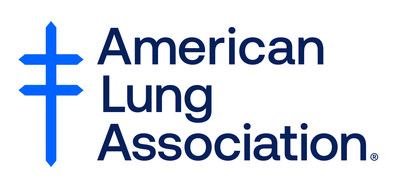New Report: Nearly Half of People in U.S. Exposed to Dangerous Air Pollution Levels
American Lung Association's 2025 "State of the Air" report finds that more people are exposed to unhealthy levels of air pollution
CHICAGO, April 23, 2025 /PRNewswire/ -- Nearly half of the people living in the U.S. breathe unhealthy levels of air pollution, according to the American Lung Association's 2025 "State of the Air" report, which was released today. In total, the report finds that 156 million people, 25 million more than last year's report, are living in areas that received an "F" grade for either ozone or particle pollution. Extreme heat and wildfires contributed to worse air quality for millions of people across the U.S.
The Lung Association's 26th annual "State of the Air" report grades exposure to unhealthy levels of ground-level ozone air pollution (also known as smog), and year-round and short-term spikes in particle pollution (also known as soot) over a three-year period. The report looks at the latest quality-assured air quality data from 2021-2023.
"Families across the U.S. are dealing with the health impacts of air pollution every day, and extreme heat and wildfires are making it worse. Air pollution is causing kids to have asthma attacks, making people who work outdoors sick, and leading to low birth weight in babies. This year's report shows the dramatic impact that air pollution has on a growing number of people," said Harold Wimmer, President and CEO of the American Lung Association. "Even as more people are breathing unhealthy air, the federal staff, programs and policies that are supposed to be cleaning up pollution are facing rollbacks, restructuring and funding challenges. For decades, the U.S. Environmental Protection Agency (EPA) has worked to ensure people have clean air to breathe, from providing trustworthy air quality forecasts to making sure polluters who violate the law clean up. Efforts to slash staff, funding and programs at EPA are leaving families even more vulnerable to harmful air pollution. We need to protect EPA."
The "State of the Air" report found that 156 million people in the U.S. (46%) live in an area that received a failing grade for at least one measure of air pollution and 42.5 million people live in areas with failing grades for all three measures. The report also found that a person of color in the U.S. is more than twice as likely as a white individual to live in a community with a failing grade on all three pollution measures. Notably, Hispanic individuals are nearly three times as likely as white individuals to live in a community with three failing grades.
The air pollutants covered in this report are widespread and can impact anyone's health. Both ozone and particle pollution can cause premature death and other serious health effects such as asthma attacks, heart attacks and strokes, preterm births and impaired cognitive functioning later in life. Particle pollution can also cause lung cancer.
Key Findings of the Report
Particle Pollution
Fine particulate matter air pollution, also known as PM2.5, particle pollution or soot, can be deadly. These particles come from wildfires, wood-burning stoves, coal-fired power plants, diesel engines and other sources. The report has two grades for particle pollution: one for "short-term" particle pollution, or daily spikes, and one for the annual average "year-round" level that represents the concentration of particles in each location.
Short-Term Particle Pollution
Deadly short-term particle pollution continues to impact communities in many parts of the country. The report finds that 77.2 million people lived in counties that experienced unhealthy spikes in particle pollution. This is the highest number in the last 16 years of this report.
The number and severity of unhealthy spikes in particle pollution improved slightly in the western states but worsened in the Midwest and Northeast. In the three years covered by this report, individuals in the U.S. experienced the highest number of days when particle pollution reached "unhealthy" (red days) and "very unhealthy" (purple days) levels in the 26 years of reporting the "State of the Air." This year's report includes data from the summer of 2023, when smoke from wildfires in Canada significantly impacted midwestern and eastern states, resulting in worse particle pollution.
Top 10 Cities Most Polluted by Short-Term Particle Pollution:
Year-Round Particle Pollution
This year's report reveals that 85 million people lived in a county that received a failing grade based on the nation's standard for year-round levels of particle pollution. This is the second largest number in the report's history—after the 90.7 million posted in last year's report.
Top 10 Cities Most Polluted by Year-Round Particle Pollution:
Ozone Pollution
Ground-level ozone pollution, also known as smog, is a powerful respiratory irritant whose effects have been likened to a sunburn of the lungs. Inhaling ozone can cause shortness of breath, trigger coughing and asthma attacks and may shorten life. Warmer temperatures driven by climate change make ozone more likely to form and harder to clean up.
After years of progress on cleaning up ozone, some communities are seeing the worst ozone levels in years. More than 125 million people (37% of the nation's population) lived in an area with unhealthy ozone pollution, which is 24.6 million more than last year's report. Extreme heat and wildfires contributed to the increase in ozone levels for many parts of the country, most notably in central states from Minnesota to Texas.
Top 10 Cities Most Polluted by Ozone Pollution:
Cleanest Cities
The report also recognizes the nation's cleanest cities. To make the cleanest list for all three measures, a city must experience no high ozone or particle pollution days and rank among the 25 cities with the lowest year-round particle pollution levels. This year, there are only two cities—Bangor, Maine and San Juan, Puerto Rico—that made the cleanest cities list for all three pollution measures. This reflects an overall worsening of air quality across the country. Last year, there were five cities on this list.
The "State of the Air" report relies on data from air quality monitors managed by state, local and Tribal air pollution control authorities in counties across the U.S. Regrettably, out of 3,221 counties in the U.S., only 922 counties are able to monitor for at least one pollutant. More than 72.8 million people live in counties where neither their ozone nor their particle pollution levels are being monitored.
In this year's "State of the Air" report, the Lung Association is calling on everyone to support and defend the EPA. EPA is essential to protecting people's health from ozone and particle pollution. Without EPA staff and programs, families won't know what's in the air they are breathing, and efforts to clean up air pollution will be undone. Join the American Lung Association in advocating to protect EPA's expert staff and lifesaving programs. See the full report results and take action at Lung.org/sota.
About the American Lung Association
The American Lung Association is the leading organization working to save lives by improving lung health and preventing lung disease through education, advocacy and research. The work of the American Lung Association is focused on four strategic imperatives: to defeat lung cancer; to champion clean air for all; to improve the quality of life for those with lung disease and their families; and to create a tobacco-free future. For more information about the American Lung Association, which has a 4-star rating from Charity Navigator and is a Platinum-Level GuideStar Member, call 1-800-LUNGUSA (1-800-586-4872) or visit: Lung.org. To support the work of the American Lung Association, find a local event at Lung.org/events.
CONTACT: Jill Dale | American Lung Association
P: 312-940-7001E: Jill.Dale@Lung.org
![]() View original content to download multimedia:https://www.prnewswire.com/news-releases/new-report-nearly-half-of-people-in-us-exposed-to-dangerous-air-pollution-levels-302435259.html
View original content to download multimedia:https://www.prnewswire.com/news-releases/new-report-nearly-half-of-people-in-us-exposed-to-dangerous-air-pollution-levels-302435259.html
SOURCE American Lung Association


